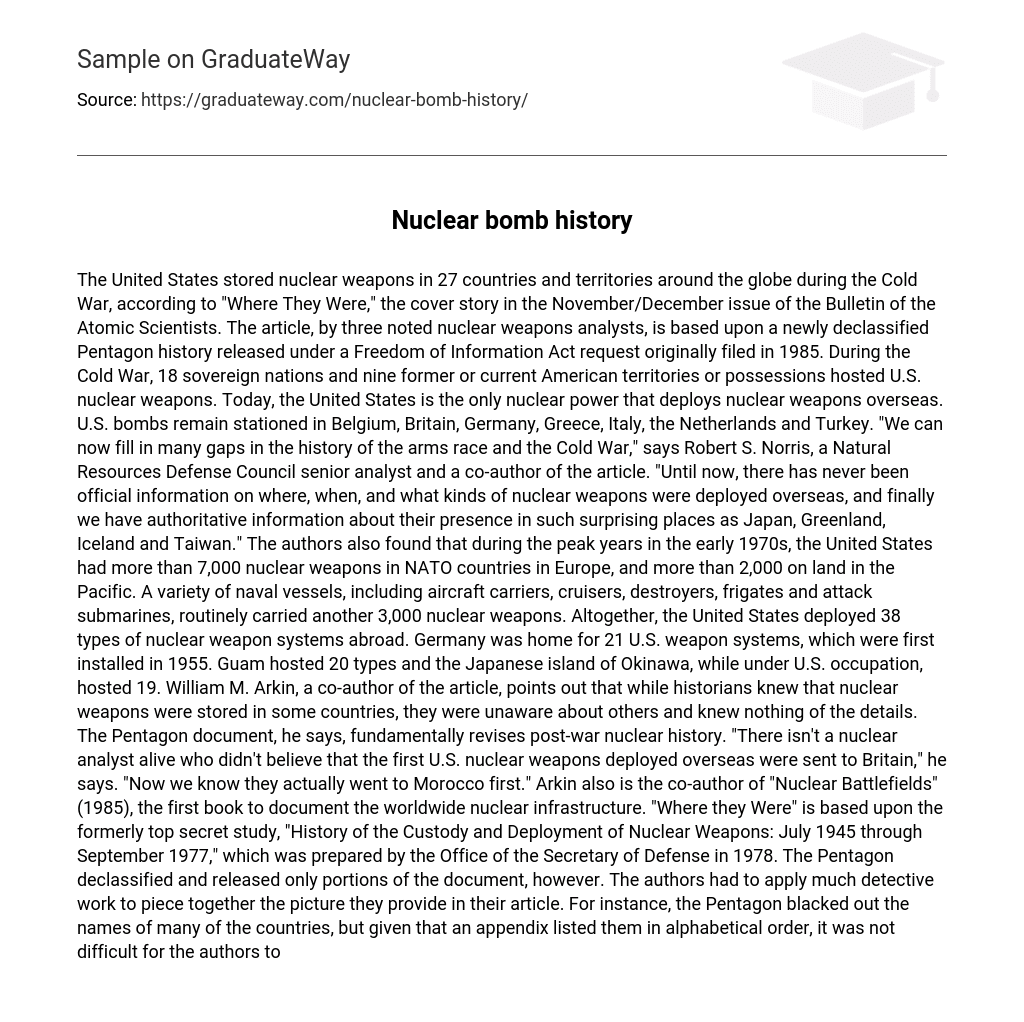During the Cold War, the United States had nuclear weapons stored in 27 countries and territories worldwide, as stated by the Bulletin of the Atomic Scientists in their cover story for the November/December issue.
The information in this article is taken from a newly revealed Pentagon history, which became accessible through a Freedom of Information Act request in 1985. The writers are respected analysts who focus on nuclear weapons. During the Cold War period, the United States had its nuclear arsenal stationed in 18 separate countries and nine American territories or possessions. Currently, the United States is still the only country to have deployed nuclear weapons outside of its own borders.
According to Robert S. Norris, a senior analyst at the Natural Resources Defense Council and co-author of the article, several countries such as Belgium, Britain, Germany, Greece, Italy, the Netherlands, and Turkey still possess bombs. This new information regarding the arms race and Cold War fills historical gaps by providing official details on the deployment of nuclear weapons overseas. Surprisingly, these weapons were discovered in unexpected locations like Japan, Greenland Iceland, and Taiwan. The authors also found that during the early 1970s, the United States had over 7,000 nuclear weapons in NATO countries in Europe and more than 2,000 on land in the Pacific.
Throughout the years, a variety of naval vessels including aircraft carriers, cruisers, destroyers, frigates, and attack submarines have consistently housed 3,000 nuclear weapons. On a global scale, the United States has utilized 38 different types of nuclear weapon systems. Since 1955, Germany has hosted 21 U.S. weapon systems.
During their occupations by the United States, both Guam and the Japanese island of Okinawa had a combined total of 39 types of nuclear weapons. Historians were aware of some countries housing nuclear weapons, but they lacked specific information and remained uninformed about others, as noted by author William M. Arkin.
The Pentagon recently published a document that presents a notable reassessment of the post-war nuclear weapons history. It was previously believed that the first nuclear weapons sent overseas were given to Britain, but recent discoveries reveal that they were actually initially sent to Morocco. The co-author of “Nuclear Battlefields,” which offers an initial comprehensive account of global nuclear infrastructure, affirms this new information. Titled “History of the Custody and Deployment of Nuclear Weapons: July 1945 through September 1977,” this study was prepared by the Office of the Secretary of Defense in 1978. Although only specific sections were made public, it has been declassified by the Pentagon.
The authors of the article had to use investigative methods in order to gather and present the information they provide. One example is the Pentagon’s redaction of the names of several countries, but since an appendix listed them in alphabetical order, the authors were able to deduce their identities easily. Only one nation remains unknown, as it was blacked out between Canada and Cuba in the list. The Pentagon’s document also includes tables that illustrate the quantity of nuclear weapons deployed in Europe, the Pacific region, and at sea.
The Pentagon redacted information on the vertical axis, but there was enough supplementary data for the authors to estimate the quantities of weapons deployed. According to co-author William Burr, an analyst at the National Security Archive, this document provides important insights into U.S. nuclear policy during the Cold War, but it also raises numerous unanswered questions. While some deployments in countries like Canada, Great Britain, and West Germany have been well-documented, the history of how the United States introduced and later removed nuclear weapons from countries such as the Philippines, Iceland, or Spain requires further explanation. Burr also points out that the redactions in the document raise concerns about deficiencies in the U.S. government’s declassification policy.
Despite the fact that the Pentagon has withdrawn nuclear weapons from numerous countries years or even decades ago, they still refuse to acknowledge key truths regarding these deployments.





